

Construction of the Gothic organ on a swallow's nest in the central nave, against the second pillar to the left when entering.
It is said that this organ was offered by Louis XI to the cathedral of Embrun.
"Arson" of the cathedral by the Huguenots.
Pierre Marchand's intervention, Flemish organbuilder. His " Prix faict " (Price) stipulate:
« de fere et mettre d’accord bien et duement les orgues de l’église métropoloitaine dudit Embrun sellon la qualité et forme de la caisse sive fust des dictes orgues qui y est à présent et iceult fornir de neuf jeux bons et suffisants à la proportion de la dite caisse de bonne durée et bonne perfection etc… »
(to make and to put all right well the organs of the metropolitan church of Embrun according to the quality and shape of the case and supply nine good and sufficient stops in proportion to the case of good duration and good perfection... )
It is specified farther than Pierre Marchand:
« sera tenu comme promet de fere troys soufflets de la longeur et largeur qu’il appartiendra… Plus fera ung sommier pour y louger les neüf jeux… »
(will have to build, as agreed, 3 bellows of the length and the width necessary more a windchest to accommodate 9 stops)
Followed by the composition of the organ and of :
« Et oultre ce sera ung tremblant, ung rossignol, ung clavier sy besoing est … ».
(and more, there will be a tremulant, a nightingale, a keyboard if necessary...)
After the complete study of the pipework which we could attribute to Pierre Marchand according to this text, we found a cornet of 5rks more, compared with the list of stops of the " Prix faict ". The sound material would have been reconstructed and planned most probably to adapt itself to the possibilities offered by a windchest of 41 manual notes. Indeed, Pierre Marchand seems to have kept the keyboard of 41 notes, however archaic for 1601.. This is confirmed on one hand by a document established 30 years later, by a monk organ builder brother Louis Jay, where the extent of a keyboard of 41 notes is specified ( « la grande monstre à 41 marches ») and by the observation of certain stemming mechanical parts of a spring windchest and of the rollerframe's plan remaining in the back of the big 18th rollerframe's board.
Twice, the organ builders Dominique and André Eustache, restore the organ. They add a "positif de dos" in the style 17th (it is the small organ of the chapel "Sainte-Anne" today). For some reasons explained in the archives texts, the Gothic case is the object of diverse transformations which, already, compromise its solidity. The Gothic lower case is moved back to allow the installation of the "positif de dos" and create so a viable space for the organist. The study of the case reveals easily these various manipulations. The pipework attributed to Marchand is entirely preserved.
The Swiss organ builder, Samson Scherrer, adds in front of the Gothic case an envelope of 18th style. He takes off the positive of the brothers Eustache, adds in replacement a new positive in the style of the new Great-organ's case. The image of the Gothic organ fades behind this case. The pipework attributed to Marchand is always preserved as well as that of the brothers Eustache of a very well made, especially the reed stops. Samson Scherrer, recomposes the organ with a "Montre" of 16 feet beginning with Fa1, but he adds only very few pipes. His intervention amounts to a "masking" of the Gothic case, a light extension of the instrumental part and the construction of 3 very beautiful walnut windchests. With the elements of the "positif de dos" of the brothers Eustache, he reconstructs the choir organ and builds a very original instrument of two keyboards. This small organ, today in the chapel "Sainte-Anne", contains none elements builds by Samson Scherrer. Instrumental parts and case coming, on one hand, from the "positif de dos" of the brothers Eustache and from the former rests of a small Gothic organ's decoration and, on the other hand, from elements of the decoration of the cathedral's Gothic organ's superstructure.
The Toulousian organ builder, Théodore Puget, restores the organ. A part of the mechanics is redone " in the standards " but all of the former pipework is always preserved. Eustache and Marchand's various stops, recomposed by Scherrer, are abundantly mixed. The composition remains roughly the same.
The Ets Gonzalez of Paris, enlarges the instrument by electric additions. They recompose the "pleins-jeux". The instrumental part stays such as Puget left it, but the voicing is adapted to the neo-classic taste. These interventions of voicing are cleanly realized, they are reversible.
Complete dismantling of both instruments, Chapel Sainte-Anne and Cathedral. The instrumental parts and the pipework are the object of a complete study which ends in a documentation of more than 300 pages. The complete dismantling of the instrumental part allows a precise examination of the whole Gothic case as well as that of the " swallow's nest" supporting the organ. Here are the conclusions of this study:
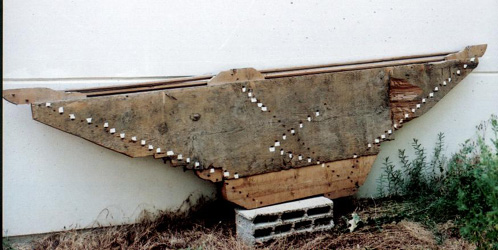
Back of the rollerframe's board of Scherrer
The visible plan is the one of a rollerframe with 5 diatonic basses on each side and the treble in tierce
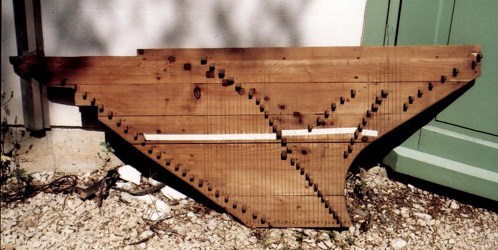
On this rollerframe's board of the chapel Sainte-Anne's small organ we see the presence of 11 studs spaced out enough (likely a pedalboard layout)
On the extreme parts of this rollerframe's board, we can see the rest of a plan in red chalk of an exit of 11 notes.
Of these observations, we can think that in 1601, a big part of the instrumental part build before Pierre Marchand was preserved. From the material taken down in June 2000, we extracted certain important mechanical parts which come to confirm this hypothesis:
Three parts of walnut (n°1: 875 x 48 x 30 mm, n°2: 859 x 48 x 30 mm, N°3: 905 x 48 x 30 mm), having served as support for the rackboards of both windchests of the Scherrer's Great-Organ, contain on a face, a series of 17 trapezoid rooms, drilled in bottom of a hole about 16mm of diameter. On the other face, this hole is framed by two saw cuts. These rooms are sized in a regular way, on one of the pieces (n°3), after an empty space, we notice for the last rooms, an alternation in their size : a large, a small, etc...
We looked for the concordance of these pieces between them. Two of them, n°1 and n°2, have an exact correspondence at the level of the series of rooms, n°3 is in concordance only on one side and for 4 rooms only. After an empty space, we count another 14 rooms The alternation of both size of rooms begins from the 4th.
This serie gives a layout exactly in compliance with that of the rollerframe's plan discovered on the big board's back of the Great-Organ's rollerframe. This rollerframe's board contains three successive plans.
- Samson Scherrer's plan for 49 notes, (the name of notes being registered with a pencil).
- A second plan (only the ruler of the keyboard) of 49 notes, (every note is written in ink), that we attribute to the brothers Eustache because of the extent of 49 notes, confirmed by the "prix faict" of 1632 and the extent of the reed stops that we attribute to them (see the study of the pipework).
- The third plan, represented by the purse's holes. This arrangement is planned for a windchest with a diatonic arrangement for 5 basses at each extremity and trebles in tierce. It is this plan which we confronted with the layout created by the corresponding links of the three pieces of walnut. The adequacy is so precise that we find even the empty spaces mentioned above.
These pieces of walnut thus come from a unique windchest, not from a windchest with registers but from a spring windchest. By deduction, we can give the extent of the windchest and naturally, that of the keyboard and the pedalboard which it contained:
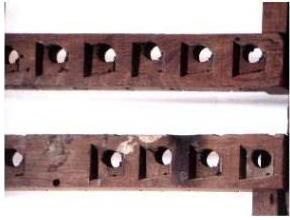

Les 3 upper boards of the ancient spring windchest in accordance and a close view of theses upper boards :
From the dismantling in June 2000, we extracted 8 wrought iron sabres of particularly old aspect, in the shape of exaggerated sheepshank. These sabres were used by Scherrer between his two windchest of the Great-Organ to return, inward of the organ and under the windchests, the movement of the registers situated at the level of the recently created facade's corbelling . The adaptation of this material was not made without any problem, and a distortion of these pieces has been necessary.
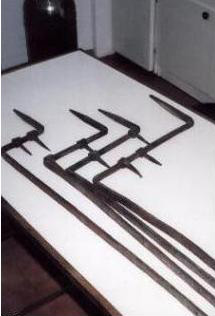 These sabres are in fact a simple reduction backfall. We notice however differences of size for each of these sabres. If the sizes are different, the ratio of beam is constant. This indicates that their positioning between the two windchests from the 18th was not correct because, the round and horizontal parts forming the axis of the beam were all arranged flat on a board and in the same level. It thus resulted oversizes on a side or on the other one. The fitting in the heads of registers was not made without weakening them.We also noticed that most of these heads were repaired by metallic brooches. A lot of holes on the biggest arm testify of the inevitable experimentation which was necessary to obtain a suitable travel.
These sabres are in fact a simple reduction backfall. We notice however differences of size for each of these sabres. If the sizes are different, the ratio of beam is constant. This indicates that their positioning between the two windchests from the 18th was not correct because, the round and horizontal parts forming the axis of the beam were all arranged flat on a board and in the same level. It thus resulted oversizes on a side or on the other one. The fitting in the heads of registers was not made without weakening them.We also noticed that most of these heads were repaired by metallic brooches. A lot of holes on the biggest arm testify of the inevitable experimentation which was necessary to obtain a suitable travel.
Those 8 pieces thus appeared to us as rather badly adapted to the configuration of a windchest with registers, on the other hand, they seem to become integrated naturally into that of a spring windchest's organ . They lend themselves naturally to the shape of the Gothic case in particular at the level of the very narrow lower case.
We propose in appendix a principal plan into which we integrate easily these 8 sabres.
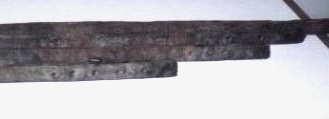 But what intrigues us most on this subject, it is the number of 8 sabres. By experience, we know that the construction of these pieces is an important work and that it was expensive (and is still expensive today). The example of the organ of Dom-Bedos in Bordeaux, even if its history is very different from that of the organ of Embrun, is not without showing certain similarity. The organ of Dom-Bedos of the old abbey Sainte-Croix of Bordeaux is probably the instrument which underwent the "traffics", the modifications, the most improbable travels of the history of organs. Nevertheless, almost all of the wrought iron stop action reached us. It had stayed in position in the case of Dom-Bedos which received two very different organs. It is obvious that the preservation of this kind of material, for any organbuilder who transforms an instrument, is a godsend the economic consequences of which are considerable.
But what intrigues us most on this subject, it is the number of 8 sabres. By experience, we know that the construction of these pieces is an important work and that it was expensive (and is still expensive today). The example of the organ of Dom-Bedos in Bordeaux, even if its history is very different from that of the organ of Embrun, is not without showing certain similarity. The organ of Dom-Bedos of the old abbey Sainte-Croix of Bordeaux is probably the instrument which underwent the "traffics", the modifications, the most improbable travels of the history of organs. Nevertheless, almost all of the wrought iron stop action reached us. It had stayed in position in the case of Dom-Bedos which received two very different organs. It is obvious that the preservation of this kind of material, for any organbuilder who transforms an instrument, is a godsend the economic consequences of which are considerable.
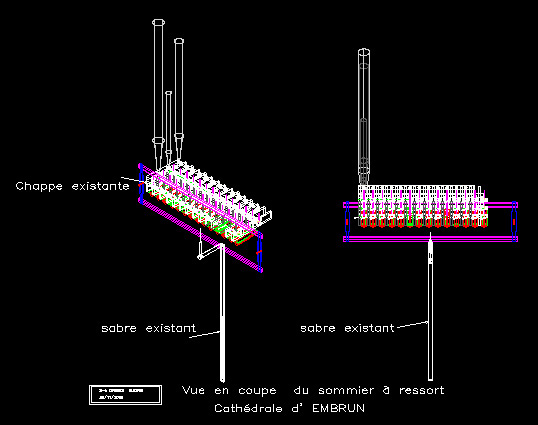
In the light of these studies, we thus formulate the hypothesis that these 8 sabres, come very certainly from the organ before Pierre Marchand and that they indicate us the order of magnitude regarding the number of registers:
The organ's composition according to its « Prix faict » in 1601 was the following :
Monstre Fleute ungysson
Octave Fleute ungysson de l’octave
Quinzième Nazard
Dix neuvième Lhérigot (2p ?)
Cimballe
Tremblant, Roussignol
Soit 9 jeux.
In these 9 stops, it is necessary to add the Cornet (one of the very first Cornet in France), which was added later probably, maybe by Marchand on the second keyboard, to be able to use it in a suitable way (its tessitura exceeding almost of an octave that of the keyboard).
Thanks to the deciphering and to the analysis of the old marks on the pipework attributed to Marchand, we were able to verify the composition and the extent of the organ's keyboard of 1601. From all the pipeworks of the two organs (chapel Sainte Anne and Cathedral) dismantled in June 2000, We were able to keep approximately 60 % of the piping 1601 or before 1601 (that is approximately 288 pipes on 479 which counted all of the organ in 1601), in particular 14 pipes made of fine tin of the old facade set up in the Gothic case. (See study of the pipework attributed to Pierre Marchand)
It remains from the instrumental part attributed to P. Marchand or before him :
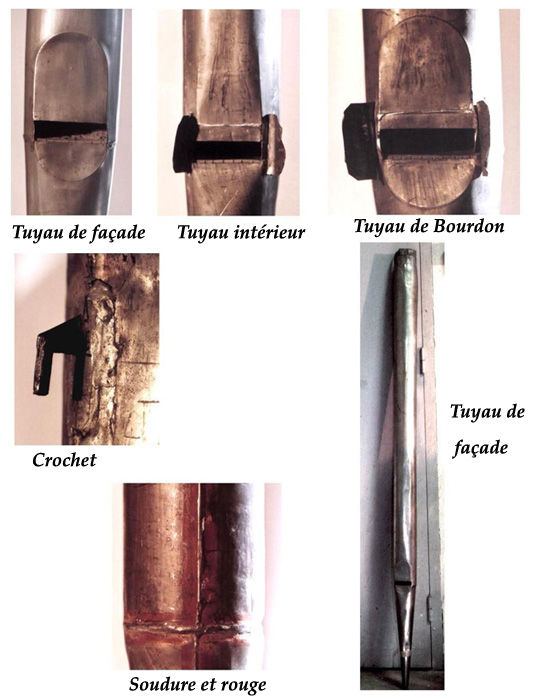
The pipes attributed to Pierre Marchand are easily recognizable. Bodies and feet are the same material, rich lead: the titration gives 7 % of tin. The metal is planed, scraped, re-tighten, never beaten. The welds are lined with a dark, easily recognizable red. Feet have a dimension very different from the other pipes of the organ (210mm at least and many other bigger feet more or less 240 to 260 mm). The flatted is Romanic for certain groups (Bourdon, Prestant) and right and long on bodies and feet for the others.
All the notes' marks of this pipework were picked up, the great majority of the pipes which we attributed to this made is provided with it. This allows to appreciate easily their sizes and their possible membership in such or such stop mentioned in the "Prix faict" of 1601. In this document, the composition of the organ is indicated. All the pipes of this made were extracted from the stops found in the dismantling. The measures of all the stops in the " state in June 2000 " were taken.
By observing scrupulously the sizes, the old marks, the lengthes of body and feet, the nature of the metal, and the various forms of flatted we can proceed to a reclassifying to find coherent suites and correspondences with the composition of the « Prix faict ».
Here is the detail :
 A series of 27 pipes with mobile cap, with its old marks of notes. All these pipes result from the same stop, the Bourdon of the positive (found in the dismantling). These pipes appear to have been provided with solded caps from the very beginning. The mobile caps were created by cut of the previous body. The scraping tracks of the metal confirm this hypothesis. This series is situated on 3 octaves and end on a C (approximately ¼ foot stopped). The first 3 pipes do not have note mark, the fourth is noted by Marchand C * (approximately 2 feet long stopped).
A series of 27 pipes with mobile cap, with its old marks of notes. All these pipes result from the same stop, the Bourdon of the positive (found in the dismantling). These pipes appear to have been provided with solded caps from the very beginning. The mobile caps were created by cut of the previous body. The scraping tracks of the metal confirm this hypothesis. This series is situated on 3 octaves and end on a C (approximately ¼ foot stopped). The first 3 pipes do not have note mark, the fourth is noted by Marchand C * (approximately 2 feet long stopped).
A series of 19 pipes opened with their original note marks, they come from various stops of the organ found in the dismantling : Piccolo, Doublette, treble of the "Montre 16", Prestant, the whole from the G.O. It is a coherent series of pipes, the size progresses in a regular way and could correspond to the size of the Prestant "Dom Bedos" narrowed of a half tone. These pipes have, up to the 1 foot, a rounding flatted on their lower and upper lip.
By observing the marks attributed to P.Marchand, registered on bodies, we find the following extent : F *, G, G *, A *, B; Pipes opened with a length which inserts them into the 4 feet octave. Then, the series continues on an almost complete octave, always with the marks attributed to Marchand. It ends on a D in the octave of the 1 foot.
 A series of 29 pipes stopped with the note marks attributed to Marchand.
A series of 29 pipes stopped with the note marks attributed to Marchand.
The first pipe (without note) of a length about 1 1/3 foot, the 2nd is marked G *.
This series is continuously.
It ends on a D *. From C (1) in D * (3), the caps are ancient. They come from the previous pipe, as all the mobile caps of the pipework attributed to Marchand. These caps are with chimney. The chimneys were recently turned inside. Some are in ancient metal.
 12 pipes with their note marks attributed to Marchand from C1 to C2 without D *.
12 pipes with their note marks attributed to Marchand from C1 to C2 without D *.
The first pipe is 2 feet long, stopped.
The four first ones have a round flatted mouth. The size of this group of pipes could correspond to the large size of Dom Bédos's Bourdon shift to a tone. The treble practically complete, from C2 to C4, are with narrow mouths = 1/6th of the circumference. They finish on a C of ½ foot. These pipes were all recut.
 19 opened pipes, all having the marks attributed to Marchand. The first pipe is noted C and is 2 feet long. In the first octave, only F is missing.
19 opened pipes, all having the marks attributed to Marchand. The first pipe is noted C and is 2 feet long. In the first octave, only F is missing.

The facade of the Chapel Sainte-Anne's small organ could be attributed to P. Marchand.
Resemblances were found as regards the soldering, the quality of the red, the Romanic flatted of mouths. These 14 pipes result from the "positif de dos" of the brothers Eustache which took them from the facade of the big Gothic organ. The feet were recut then resoldered very boorishly to decrease the diameter of the foot base to create a line of mouths better integrated into the 17th style's positive. Behind these pipes, we find a strange molded hook of tin, with a beautiful shape. These hooks are all solded at the same height, they were used when these pipes were in the Gothic case.

It is a series of 13 pipes, on an extent of approximately 2 octaves. The first one measures 2 feet approximately (diameter = 43,6 mm). It is noted D (mark attributed to Marchand). The lengthes are rather ill-assorted but the size is regular. Three pipes (attributed to Marchand) unclassifiable could be inserted into the diapason of this stop so that they can be used. This stop could be the 19th of 1 1/3 feet.
 This group of 10 pipes (the first one measures 1,5 foot, diameter = 29 mm) has the mouths more narrow (1/7th of the circumference) than those of the series attributed to the treble of the Flûte 4p. The lengthes are ill-assorted.
This group of 10 pipes (the first one measures 1,5 foot, diameter = 29 mm) has the mouths more narrow (1/7th of the circumference) than those of the series attributed to the treble of the Flûte 4p. The lengthes are ill-assorted.
 A group of 10 small pipes with bodies in tin, recut. He could result from the rank of "Cymbal". According to Jean Fellot, in its work on the " Plein-Jeu Français", the stop of cymbal in this period consisted of a single row, mostly on the 22nd. With the marks of notes attributed to P. Marchand, the size is then coherent for a 22nd (1 foot). It could correspond approximately to the size of the "Doublette" Dom Bédos. This stop is the only one in tin.
A group of 10 small pipes with bodies in tin, recut. He could result from the rank of "Cymbal". According to Jean Fellot, in its work on the " Plein-Jeu Français", the stop of cymbal in this period consisted of a single row, mostly on the 22nd. With the marks of notes attributed to P. Marchand, the size is then coherent for a 22nd (1 foot). It could correspond approximately to the size of the "Doublette" Dom Bédos. This stop is the only one in tin.

These 5 Marchand's ranks are of an extent going from D3 to C5. All the pipes have Marchand's mark. The Bourdon is good in the lengthes bordering the 1 foot long, as well as the prestant. Feet are short.



ancient marks attributed to Marchand
After observation, we notice a perfect similarity between the reed stops "Trompette, Clairon, Voix humaine, Cromorne" stemming from the general dismantling on June 2000: the same not hammered alloy, the same blocks, the same rings, the same reeds. The assembly of the body on the block is made by emmanchement in the upper continuation of the block. The whole is then solded. This particular system is noticed on all the reed pipes of the organ. This brings us to suppose that these stops are of the same organbuilder.
The « Prix faict » 1632 indicates us that Dominique Eustache supplied the instrument of a "Trompette" and a "Voix humaine". We can then deduct that the other reed stops are also probably of this organbuilder or maybe his brother André (1656). Some texts relative to André Eustache's intervention do not mention it.
Between 1656 and 1750 (Sherrer), we find nothing in archives concerning new reed stops.
Numerous feet of these stops were changed by others of hammered plain metal, but some of origin remain, in plain metal (20 %), scraped across.
This particular way of scraping the material is also noticed in the stops of "Bourdon" G.O., "Tierce" Positive, "Tierce" G.O., and "Doublette" Positive (name of the stops in the dismantling). We can then think that these pipes are probably of the same period than the reeds above described. We suppose them of the brothers Eustache's hand.
In this group of pipes, identified by observation and attributed to the Eustache's period , we could find components, of a "Ttierce", a "Bourdon" and some pipes of narrow size ("Plein-jeu" or "Doublette"). 17 pipes of a stop of "Flûte" in the range of the 1 feet are also added to this group.
These various series of pipes, of the same made, appear in good adequacy with the stops of the new "positif de dos" added in 1632 the precise list of which we have. This one is confirmed by the « Prix faict » of Dominique Eustache(Archives dép. Des Hautes Alpes 1E1587 )
In conclusion, here is the list of the stops which would have been made by the brothers Eustache :
- Trompette (complete)
- Voix humaine (complete)
- Cromorne (complete)
- Clairon (39 pipes)
- Flûte, le premier mesure 1 foot, (17 pipes)
- Tierce, le premier mesure 1 3/5 foot (15 pipes),
- Bourdon, (16 pipes)
- Various pipes of "plein jeu" ou "Doublette" (10)
All these pipes attributed to Eustache have no mark of origin. The only marks are the ones of S.Sherrer who had to re-note them to identify them after reclassifying. The restoring of the sizes of origin for these flue stops can thus be made only in a theoretical way.
Composition of the Brothers Eustache
| Grand-Orgue - 49 notes | Positif - 49 notes | Pédale - 12 notes |
| Montre 8' | Bourdon 8' | Flûte 8' |
| Bourdon 8' | Montre 4' | |
| Prestant 4' | 15ème 2' | Tirasse |
| Flûte à fuseau 4' | 19ème 1 1/3' + 22ème 1' | |
| 15ème 2' | Larigot 1 1/3' | |
| Tierce 1 3/5' | Cromorne 8' (installés en 1635 ou 1656) | |
| 19ème 1 1/3' | ||
| 22ème 1' | ||
| Cymbale ? | ||
| Nazard 2 2/3' | ||
| Cornet 5 rgs | ||
| Voix humaine 8' | ||
| Trompette 8' (installés en 1635 ou 1656) | ||
| Clairon 4' (installés en 1635 ou 1656) |
Intervention of Pierre Vejux for a large amount ( 4050 livres). The made is typically 18th in hammered plain metal with wide solderings without track of red. These pipes cannot be compared with the reed stops which seem older and the feet's plain metal of which is originally, scraped. Furthermore, the solderings are very different.
All these pipes of hammered plain metal are spread in various organ's stops, without any mark of origin. We attributed them to P.Véjux. Archives inform us only about few things on the intervention of this organbuilder, set apart the construction of a "Cornet d'écho"(Arch. dép. Des Hautes Alpes G675).
We also attribute to Pierre Véjux, the windchest (25 notes) for a cornet 6 rks, found against the small organ of the chapel Sainte-Anne, with its rollerframe and its series of backfalls. (No other archives speaks about an organbuilder building a windchest of 25 notes). This windchest is of the same made as the small pedal's windchest of 12 notes of the chapel Sainte-Anne's organ.
Three groups, recomposed from pipes attributed to Véjux, seem to come, in a very obvious way, from ranks of this "Cornet d'écho":
- 8 feet open (22 pipes), (coming from the "Flûte 8" of the positive in the dismantling)
- A rank of "Bourdon 8" (17 pipes) (coming from the bass of "Nasard" of the positive in the dismantling),
- 6 pipes (coming from the "Tierce" and the "Piccolo" of the positive in the dismantling, maybe coming from a rank of a "Prestant de Cornet".
These pipes were presented on the windchest of echo the rack board of which was preserved. They found their place naturally by fitting suitably into the old rack board.
Other groups, which could not fit on the windchest of echo seem to be complements. Pipes found in bulk in the organ of the chapel Sainte-Anne are of the same made. Numerous feet of reeds replaced feet of flue pipes. (See the study report on the small organ).
the facades of Samson Sherrer :
All the facades pipes, Great-Organ and Positive, are of this organbuilder. Certain facade pipes of the G.O. were transformed into dummy pipes, others had posting moved to insert C*1 which did not exist because the « Prix faict » of Samson Scherrer mention the existence of a « A, mi , Ao on the C# for all the stops».
The tuning slots and windows were enlarged to set up the tone. These modifications are very visible.
Repairs were sometimes executed with zinc. The marks found on these pipes concern only the numbering to define the place in the facade, but there is no mark of note. This facade is well made, in burnished tin. No pipe has sign of collapse.
The inside pipework :
Curiously, the metal is not hammered. Bodies are of tin, feet of plain metal. We identified and attributed this piping to Scherrer by observing the particular scraping tracks in the back of the facade pipes. These tracks testify of a scraping made with a "metal plane". Tracks left by the tool are exactly the same for the facade of Scherrer that for the inside pipes which we attribute to him.
This pipework noted well by Scherrer is constituted of the treble of the various stops the basses of which are in facade, of a group of "Plein-jeu" pipes of big size, of a treble of "Nazard", and various groups of some pipes being complements to stops :
- Treble of "Montre 16" (8 pipes)
- Treble of "Montre 8" (24 pipes)
- Treble of "Prestant" G.O. (26 pipes )
- "Plein-jeu" (82 pipes seriously damaged)
- Treble of nazard (23 pipes, only the bodies, the feet are from Marchand)
- Treble of "Montre 4" positive (13 pipes)
- Various groups of complements.
Thanks to the analysis of the Scherrer marks and the sizes of these pipes, this classification was able to succeed. The trebles of the various stops of "Montre" as they were placed in the organ before the dismantling in June 2000 did not turn out to be in their position of origin. Numerous pipes of the same diameter, same notes Scherrer, recut, constituted the treble of the "Montre 16", "Prestant 4". These pipes could belong most probably only to the "Plein-Jeu" which Scherrer recomposed.
Only the treble of the "Montre 8" has not be transformed, a single pipe was missing. It was found in a group of complement pipes, thanks to the marks.
We can thus conclude that Samson Scherrer remade new all the stops of "Montre" as well as their trebles. Furthermore, he had to modify the "Plein-jeu" or add new ranks, to rescale certain stops and maybe to redo defective pipes.
Composition of Samson Scherrer - 1750

| Grand-Orgue - 49 notes | Positif - 49 notes | Echo - 25 notes |
| A0 sur C#1 ? (14 chapes) | A0 sur C#1 ? (7 chapes) | clavier ajoutée en 1728 par Véjux |
| Montre 16' | Bourdon 8' | Cornet 6 rgs (8, 8, 4, 2 2/3, 2, 1 3/5) |
| Montre 8' | Montre 4' | |
| Bourdon 8' | Dessus de flûte allemande 4' | |
| Prestant 4' | Nasard 2 2/3' | |
| Fourniture 4 rgs | Doublette 2' | |
| Cymbale 3 rgs | Tierce 1 3/5' | |
| Flûte 4' | Larigot 1 1/3' | |
| Nasard 2 2/3' | Plein jeu 3 rgs | |
| Doublette 2' | Cromorne 8' | |
| Tierce 1 3/5' | ||
| Cornet 5 rgs | ||
| Voix humaine 8' | ||
| Trompette 8' | ||
| Clairon 4' |
Pedal: nothing is indicated in the agreement made with Scherrer on December 22nd 1750.
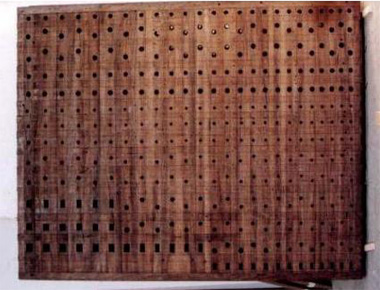
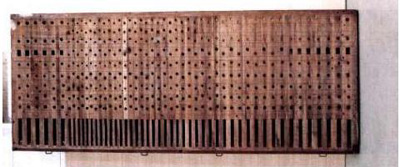
Windchests Scherrer G.O. and Positive

The Gothic case exists in a very big part. Only a part of the elements of the superior decoration is missing. This one was on the case of the small organ of the chapel Sainte-Anne. The reconstruction of this decoration is made likely by the numerous tracks of joinings (rebates, grooves, mortises) which are very visible on the posts of the Gothic facade. These joinings position very exactly the decoration which fits naturally according to the theoretical lengthes of the facade pipes.
The numerous decorative motives of all the Gothic lower case remained intact, would allow a probably very nearby reconstruction of the original. We present a polychromatic drawing of restoration of the whole case on its swallow's nest. The bridge of access to the swallow's nest has, on the side of the nave, a parapet with Gothic motives' carved panels. According to the testimony of Mr Alix, who was the organist of the Cathedral's organ, this parapet was formerly behind a wall which masked the old blowers. Mr Alix knew the time when this wall was still existing. It was destroyed in 1955 by the M.H. We do not understand why this Gothic parapet was removed and put up back to front (the sculptured Gothic panels are turned to the wall). It is always in position at present, with modern panels of joinery, well done but without interests. Our drawing restores this Gothic parapet. It also restores the polychromy of the swallow's nest which, after testing, showed to be polychromatic (blue, vermilion red and gold).


The various modifications by the brothers Eustache (on 1656, 1750) of this case led to the sawing of the distribution's block of the load of the instrumental part and of the case. This block of strong section distributed the load of the organ on two big cross bars in console of the swallow's nest. The sawing of this vital part of the whole was made during the side movements of the low structure. Today, the organ leans exclusively on a floor of only 27 mm thick.
In 1750, Samson Scherrer adds the new decoration corbelling in regard with the Gothic lower case. The weight of this new decoration and of the 16 foot facade is estimated at 1,5 Ton. The overhang increases this weight to 2,5 Ton, in shear failure on the Gothic lower case. Then, this one does not stop deforming. It will go to the crack of side elements of the Gothic structure. The whole which lied only on a thickness of floor of 27 mm sank irreparably into the swallow's nest.
The study of the pipework attributed to Marchand reveal that almost 60 % of the sound material of 1601 or before, which existed in the Gothic case remains. Its very good state of preservation allows a precise restoration with the manufacturing of complements simple to determine.
The study of the pipeworks of the brothers Eustache lets appear the very complete group of the 17th century's Provençal made.
Samson Scherrer's pipes (especially the complements of the facade) are minority in proportion, but the group Eustache / Scherrer constitute an entity strongly typified "17th century". Samson Scherrer's magnificent windchests are of a perfect adequacy with the ancient pipework of Eustache that Samson Scherrer got back as it was in 1750.
The 18th decoration, Great-Organ and Positive, the Scherrer's windchests, the Eustache / Scherrer's pipework thus constitute a homogeneous instrument in itself. We had proposed the idea that this group could have been set up in the left aisle at the level of the choir, on a gallery designed with a minimum footprint. This situation would not have been unfavorable to a good sound diffusion. The integration in the architecture could seem without conflict, the Romanic window and the door of the old sacristy being completely cleared. This idea, the objective of which was in reality to be able to reconstitute the Gothic case on its swallow's nest with the Pierre Marchand's sound and mechanical elements, was rejected by the regional Preservation of Historic monuments very probably for budgetary questions but also to be in conformity with the " Charter of Venice " which stipulates that the strata of the history of a monument must not be separated.

Reconstitution of the gothic case